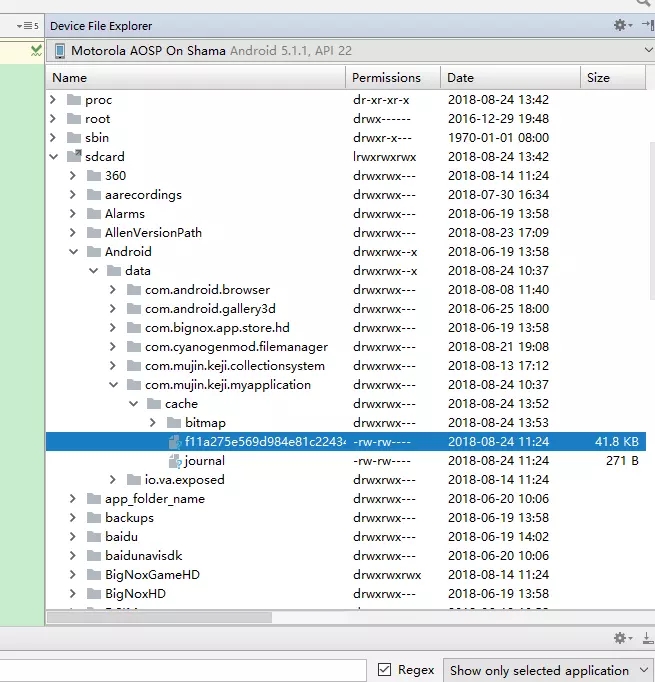DiskLruCache和LruCache不同的是,LruCache是内存缓存,而DiskLruCache是指磁盘缓存,顾名思义就是把文件缓存到磁盘,也也就是手机的内存卡中。接下来先简单介绍DiskLruCache的使用方法。
下载源码
DiskLruCache并没有在 SDK中存在,但又是谷歌提倡的。所以我们要先把DiskLruCache的源码下载下来。
我们可以通过下面这个地址下载源码:https://github.com/JakeWharton/DiskLruCache/tree/master/src/main/java/com/jakewharton/disklrucache
然后把源码中的三个类拷贝到工程中。
DiskLruCache常用方法:
| 方法 | 备注 |
|---|---|
| DiskLruCache open(File directory, int appVersion, int valueCount, long maxSize) | 打开一个缓存目录,如果没有则首先创建它,directory:指定数据缓存地址 appVersion:APP版本号,当版本号改变时,缓存数据会被清除 valueCount:同一个key可以对应多少文件 maxSize:最大可以缓存的数据量 |
| Editor edit(String key) | 通过key可以获得一个DiskLruCache.Editor,通过Editor可以得到一个输出流,进而缓存到本地存储上 |
| void flush() | 强制缓冲文件保存到文件系统 |
| Snapshot get(String key) | 通过key值来获得一个Snapshot,如果Snapshot存在,则移动到LRU队列的头部来,通过Snapshot可以得到一个输入流InputStream |
| long size() | 缓存数据的大小,单位是byte |
| boolean remove(String key) | 根据key值来删除对应的数据,如果该数据正在被编辑,则不能删除 |
| void delete() | 关闭缓存并且删除目录下所有的缓存数据,即使有的数据不是由DiskLruCache 缓存到本目录的 |
| void close() | 关闭DiskLruCache,缓存数据会保留在外存中 |
| boolean isClosed() | 判断DiskLruCache是否关闭,返回true表示已关闭 |
| File getDirectory() | 缓存数据的目录 |
初始化缓存对象
接下来具体介绍DiskLruCache的简单方法。首先我们在使用某个类的时候,一般都是首先找到它的构造方法,但是我们发现该类是final 类,无法被继承,并且构造方法是私有的方法,不能手动调用。
public final class DiskLruCache implements Closeable {
private DiskLruCache(File directory, int appVersion, int valueCount, long maxSize) {
this.directory = directory;
this.appVersion = appVersion;
this.journalFile = new File(directory, JOURNAL_FILE);
this.journalFileTmp = new File(directory, JOURNAL_FILE_TEMP);
this.journalFileBackup = new File(directory, JOURNAL_FILE_BACKUP);
this.valueCount = valueCount;
this.maxSize = maxSize;
}
所以在初始化DiskLruCache的时候调用它的open方法
//四个参数分别为,1.缓存的路径目录 2.版本号 3.每个节点对应的数据个数,4.缓存的大小,10 * 1024 * 1024 = 10M
DiskLruCache diskLruCache = DiskLruCache.open(getCachFile(context, uniqueName), 1, 1, cacheSize);
/**
* 获取缓存目录
*
* @param context
* @param uniqueName 指定目录下的文件名
*/
private File getCachFile(Context context, String uniqueName) {
String catchPath;
//有内存卡,并且内存卡没有正在移除,就把文件缓存到内存卡中
if (Environment.MEDIA_MOUNTED.equals(Environment.getExternalStorageState()) || !Environment.isExternalStorageRemovable()) {
catchPath = context.getExternalCacheDir().getPath();
} else {
catchPath = context.getCacheDir().getPath();
}
return new File(catchPath + File.separator + uniqueName);
}
要传入四个参数:
传入sdcard缓存的目录的时候,记得先判断sdcard是否存在,或者sdcard是否正在移除。如果是这两种情况。缓存目录就设置为getCacheDir().getPath();在内存中缓存。
写入缓存
初始化缓存完成之后,就写入缓存,这个时候需要从网上下载一张图片。
new Thread() {
@Override
public void run() {
DiskLruCache.Editor editor = null;
try {
//创建 Editor 对象
editor = diskLruCache.edit(hashKeyForDisk(url));
if (editor != null) {
//创建输出流
OutputStream outputStream = editor.newOutputStream(0);
//url 也就是 下载图片的地址
//outputStream 的作用在于,
//从网络下载图片的时候,图片通过该输出流写到文件系统,
//也就是说,图片下载到了磁盘缓存中。
if (downloadUrlToStream(url, outputStream)) {
editor.commit();
} else {
//释放编辑锁
editor.abort();
}
diskLruCache.flush();
}
} catch (Exception e) {
e.printStackTrace();
}
}
}.start();
/**
* 将key进行加密
*
* @param key
* @return
*/
public String hashKeyForDisk(String key) {
String cacheKey;
try {
final MessageDigest mDigest = MessageDigest.getInstance("MD5");
mDigest.update(key.getBytes());
cacheKey = bytesToHexString(mDigest.digest());
} catch (NoSuchAlgorithmException e) {
cacheKey = String.valueOf(key.hashCode());
}
return cacheKey;
}
private String bytesToHexString(byte[] bytes) {
StringBuilder sb = new StringBuilder();
for (int i = 0; i < bytes.length; i++) {
String hex = Integer.toHexString(0xFF & bytes[i]);
if (hex.length() == 1) {
sb.append('0');
}
sb.append(hex);
}
return sb.toString();
}
我们首先初始化 DiskLruCache.Editor editor对象,把图片的url经过MD5加密,然后作为缓存图片的key。这里为什么不直接用url作为key而要进行md5加密呢。因为url中,可能存在一些特殊字符,这样一来可能在命名文件的时候不合法。 md5加密之后的字符是唯一的,并且都是0-F的字符。然后创建OutputStream outputStream对象
OutputStream outputStream = editor.newOutputStream(0);
下载图片之后就是通过该输出流进行写入文件,也就是说,把下载下来的图片写入到缓存目录中。
//也就是说,图片下载到了磁盘缓存中。
if (downloadUrlToStream(url, outputStream)) {
editor.commit();
} else {
//释放编辑锁
editor.abort();
}
diskLruCache.flush();
下载成功后调用 editor.commit();提交即可。
我们具体看下下载图片的方法
/**
* 从网络中下载图片,并写到缓存中
*
* @param urlString
* @param outputStream
* @return
*/
private boolean downloadUrlToStream(String urlString, OutputStream outputStream) {
HttpURLConnection urlConnection = null;
BufferedOutputStream out = null;
BufferedInputStream in = null;
try {
final URL url = new URL(urlString);
urlConnection = (HttpURLConnection) url.openConnection();
in = new BufferedInputStream(urlConnection.getInputStream(), 8 * 1024);
out = new BufferedOutputStream(outputStream, 8 * 1024);
int b;
while ((b = in.read()) != -1) {
out.write(b);
}
return true;
} catch (final IOException e) {
e.printStackTrace();
} finally {
if (urlConnection != null) {
urlConnection.disconnect();
}
try {
if (out != null) {
out.close();
}
if (in != null) {
in.close();
}
} catch (final IOException e) {
e.printStackTrace();
}
}
return false;
}
我们看到下载的图片写到 OutputStream outputStream中,也就是写到了缓存中。这样一来就把图片写到了缓存中了。
我们看下缓存图片的目录:

我们看到这里有一个journal文件和一个名字很长的文件,名字很长的文件,就是我们的缓存文件了,因为是经过md5加密后的字符串。
读取缓存
接下里我们介绍如何读取缓存文件。
DiskLruCache.Snapshot snapshot = diskLruCache.get(hashKeyForDisk(url));
if(snapshot!=null){
InputStream inputStream = snapshot.getInputStream(0);
Bitmap bitmap = BitmapFactory.decodeStream(inputStream);
//如果不为空,则直接展示缓存中的bitmap
imageView.setImageBitmap(bitmap);
}
这里为什么是getInputStream(0);呢。因为我们上面定义了一个key对应一个数据,所以只获取第0个即可
我们看下运行的效果图:

移除缓存
调用remove方法,移除指定的数据。
public synchronized boolean remove(String key) throws IOException
其他api
1.flush()
用于将内存中的操作记录同步到日志文件,也就是sdcard中的journal文件。DiskLruCache正常工作就要依赖该文件中的内容。但是没必要每次写入缓存操作的时候都调用一次,一般在Activity的onPause方法中调用一次即可。
2.delete()
删除所有的缓存
以上就是本文的全部内容,希望对大家的学习有所帮助,也希望大家多多支持亿速云。
免责声明:本站发布的内容(图片、视频和文字)以原创、转载和分享为主,文章观点不代表本网站立场,如果涉及侵权请联系站长邮箱:is@yisu.com进行举报,并提供相关证据,一经查实,将立刻删除涉嫌侵权内容。